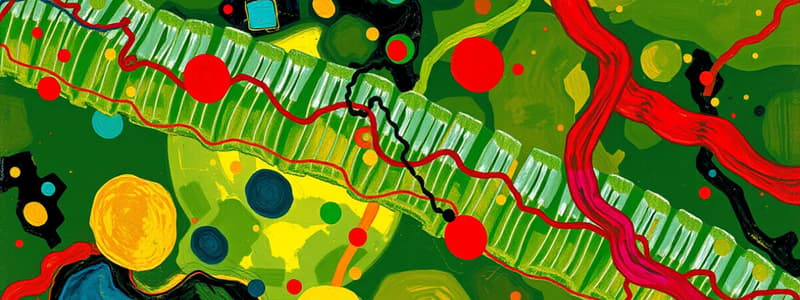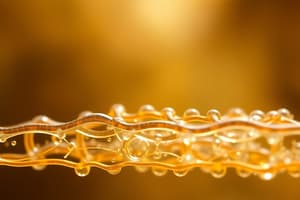Podcast
Questions and Answers
What is the main structural component of the plasma membrane?
What is the main structural component of the plasma membrane?
- Nucleic acids
- Carbohydrates
- Lipid bilayer (correct)
- Proteins
What is the characteristic of phosphoglycerides that makes them suitable as membrane lipids?
What is the characteristic of phosphoglycerides that makes them suitable as membrane lipids?
- They are non-polar
- They are exclusively saturated
- They contain a hydrophilic phosphate group (correct)
- They are hydrophobic only
The fluid mosaic model of the plasma membrane emphasizes which of the following concepts?
The fluid mosaic model of the plasma membrane emphasizes which of the following concepts?
- Static arrangement of proteins
- Dynamic movement of lipid and protein components (correct)
- Presence of carbohydrates only
- Rigidity of the membrane
Which fatty acids are found in high concentrations in fish oil?
Which fatty acids are found in high concentrations in fish oil?
What contributes to the semipermeable nature of the plasma membrane?
What contributes to the semipermeable nature of the plasma membrane?
Which type of bond predominantly holds the lipid-protein assemblies of membranes together?
Which type of bond predominantly holds the lipid-protein assemblies of membranes together?
What type of fatty acids are characterized by possessing double bonds?
What type of fatty acids are characterized by possessing double bonds?
In what form are the fatty acids in phosphoglycerides primarily esterified?
In what form are the fatty acids in phosphoglycerides primarily esterified?
What categorizes EPA and DHA as omega-3 fatty acids?
What categorizes EPA and DHA as omega-3 fatty acids?
Which type of lipids are sphingolipids derived from?
Which type of lipids are sphingolipids derived from?
What comprises the glycocalyx?
What comprises the glycocalyx?
Which statement about blood type A individuals is accurate?
Which statement about blood type A individuals is accurate?
How do integral proteins differ from peripheral proteins?
How do integral proteins differ from peripheral proteins?
What process primarily contributes to the formation of the extracellular matrix in most cells?
What process primarily contributes to the formation of the extracellular matrix in most cells?
What are temporary tethers that connect two organelles during communication in a cell known as?
What are temporary tethers that connect two organelles during communication in a cell known as?
Which organelles are best characterized for forming contact sites?
Which organelles are best characterized for forming contact sites?
What type of secretion involves materials being released only in response to a stimulus?
What type of secretion involves materials being released only in response to a stimulus?
During vesicle transport, which proteins become part of the recipient membrane?
During vesicle transport, which proteins become part of the recipient membrane?
Where are proteins commonly synthesized before modification in the Golgi complex?
Where are proteins commonly synthesized before modification in the Golgi complex?
What type of cells typically utilize regulated secretion for their secretory activities?
What type of cells typically utilize regulated secretion for their secretory activities?
What happens to soluble proteins in a transport vesicle when it fuses with a recipient membrane?
What happens to soluble proteins in a transport vesicle when it fuses with a recipient membrane?
What is the primary role of COPII-coated vesicles?
What is the primary role of COPII-coated vesicles?
Which statement accurately describes lysosomes?
Which statement accurately describes lysosomes?
What is the primary function of the plant vacuole?
What is the primary function of the plant vacuole?
What characterizes receptor-mediated endocytosis?
What characterizes receptor-mediated endocytosis?
What is the Cis-Golgi Network (CGN) primarily known for?
What is the Cis-Golgi Network (CGN) primarily known for?
Which of the following describes bulk-phase endocytosis?
Which of the following describes bulk-phase endocytosis?
What is the optimal pH for the acid hydrolases found in lysosomes?
What is the optimal pH for the acid hydrolases found in lysosomes?
Which of the following correctly identifies a function of Clathrin-coated vesicles?
Which of the following correctly identifies a function of Clathrin-coated vesicles?
Which of the following correctly describes the rough endoplasmic reticulum (RER)?
Which of the following correctly describes the rough endoplasmic reticulum (RER)?
What is the main function of the smooth endoplasmic reticulum (SER) in liver cells?
What is the main function of the smooth endoplasmic reticulum (SER) in liver cells?
How does the endocytic pathway differ from the secretory pathway?
How does the endocytic pathway differ from the secretory pathway?
What role do ribosomes play in the rough endoplasmic reticulum?
What role do ribosomes play in the rough endoplasmic reticulum?
Which of the following best characterizes the Golgi complex?
Which of the following best characterizes the Golgi complex?
What type of granules store materials to be secreted within certain cells?
What type of granules store materials to be secreted within certain cells?
What cellular structure evolved from invaginations of the plasma membrane?
What cellular structure evolved from invaginations of the plasma membrane?
What component is primarily responsible for the process of detoxification in the smooth endoplasmic reticulum?
What component is primarily responsible for the process of detoxification in the smooth endoplasmic reticulum?
Flashcards are hidden until you start studying
Study Notes
Plasma Membrane
- The plasma membrane, also known as the cell membrane, has a width of 5-10 nm and exhibits a trilaminar appearance.
- Functions as a semipermeable barrier, selectively allowing substances to pass through.
Fluid Mosaic Model
- Proposed by Singer and Nicholson in 1972, it describes the structure of the plasma membrane as a dynamic mix of lipids and proteins.
Chemical Composition of Membranes
- Membranes are formed from lipid-protein assemblies held by noncovalent bonds, predominantly structured as a lipid bilayer.
- Variation in the lipid-to-protein ratio depends on the type of membrane, organism, and cell type.
Membrane Lipids
- Membrane lipids are amphipathic, featuring both hydrophilic and hydrophobic regions.
- Main types include phosphoglycerides, sphingolipids, and cholesterol.
Phosphoglycerides
- Most abundant membrane lipids with a glycerol backbone and one phosphate group, categorized as diglycerides.
- Comprised of saturated, monounsaturated, and polyunsaturated fatty acids.
Unsaturated Fatty Acids
- Characterized by the presence of double bonds, affecting lipid properties and flexibility.
Clinical Correlate: Fish Oil
- Contains high concentrations of omega-3 fatty acids: eicosapentaenoic acid (EPA) and docosahexaenoic acid (DHA), crucial for brain and retina function.
Cholesterol and Sphingolipids
- Cholesterol maintains membrane fluidity.
- Sphingolipids, derived from sphingosine, include ceramides, sphingomyelin, and glycolipids.
Membrane Carbohydrates
- Glycocalyx acts as a sugar coat, primarily consisting of glycoproteins (90%) and glycolipids (10%).
- Blood type varies due to specific enzymes that modify carbohydrate chains.
Membrane Proteins
- Integral proteins span the membrane while peripheral proteins associate with membrane surfaces without spanning them.
- Lipid-anchored proteins are attached to lipids in the membrane.
Endomembrane Systems
- Cells create temporary connections between organelles, particularly well characterized in ER-mitochondria and ER-Golgi interactions.
Vesicle Transport Mechanism
- Involves budding where proteins and soluble substrates are packaged into vesicles for transport between cellular compartments.
Secretory Pathway
- Processes involve protein synthesis in the rough ER, modification in the Golgi complex, and delivery to various destinations like the plasma membrane or lysosomes.
Types of Secretion
- Constitutive secretion releases materials continuously, contributing to matrix and membrane formation.
- Regulated secretion stores materials for release upon stimulation, significant in endocrine and nerve cells.
Endocytic Pathway
- Operates oppositely to secretion, moving materials from the external cell surface into internal compartments like endosomes and lysosomes.
- Two types: bulk-phase (nonspecific) and receptor-mediated (specific).
Endoplasmic Reticulum (ER)
- Evolved from plasma membrane invaginations, consists of rough ER (ribosome-studded) and smooth ER (no ribosomes).
- Rough ER synthesizes proteins while smooth ER is involved in lipid synthesis and detoxification processes.
Golgi Complex
- Composed of flattened membranous cisternae, it modifies and sorts materials received from the ER.
- Operates via distinct compartments: cis (CGN) and trans (TGN) faces for sorting and delivery.
Coated Vesicles
- COPII-coated vesicles transport materials from the ER to the Golgi.
- COPI-coated vesicles move materials retrograde, while clathrin-coated vesicles transport materials to endosomes and lysosomes.
Lysosomes
- Serve as the cell's digestive organelles, containing acid hydrolases that function optimally at acidic pH.
- Involved in autophagy, a process of cellular self-digestion and turnover.
Plant Vacuole
- Occupies 90% of plant cell volume, serving as a storage for solutes and toxic compounds.
- Intracellular digestion occurs here, aided by active transport systems for ion concentration regulation.
Studying That Suits You
Use AI to generate personalized quizzes and flashcards to suit your learning preferences.




